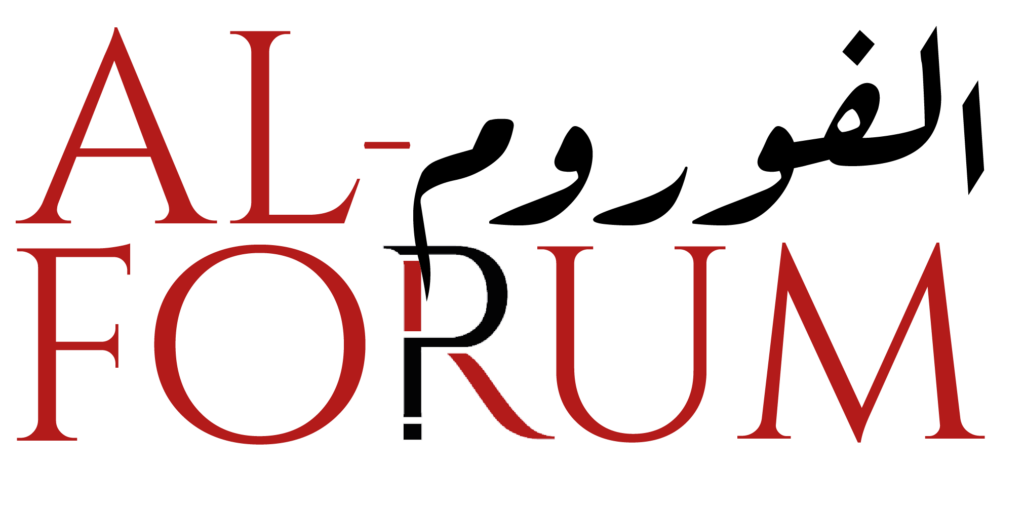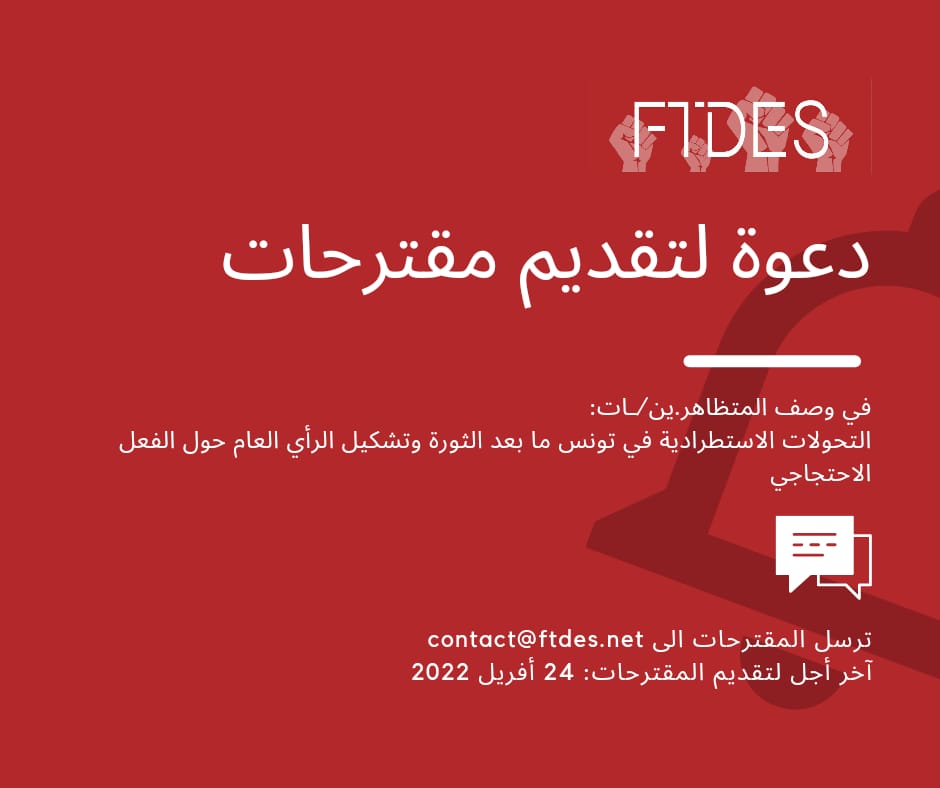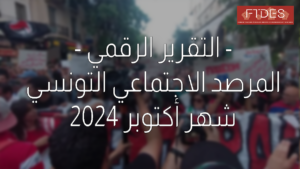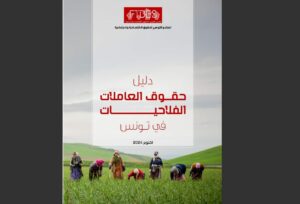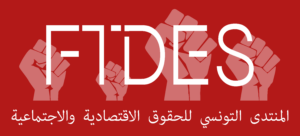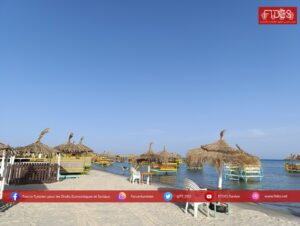Portraying Protestors:
Discursive shifts in Tunisia and the making of public perceptions and attitudes
Call for Proposals
Beyond immediate effect and responses, social movements and grassroots actors play a key role in the political and historical trajectory of the country but also in the social transformations it continues to witness since 2010. And while social protests and movements in Tunisia are not a post-uprising product and do have a long history, their realm of agency, frequency, size, demands, and forms have displayed significant transformations since the 2010/2011 uprising, and continue to face resistance aiming at curbing their potential and often resorting to authoritarian practices.
The scope of this call refers to a long-standing debate, constantly renewed, and mainly involving three spheres: the elites, the media, and social movements and grassroots actors at large. This triangle represents a complex net of power dynamics where these spheres interact via different structures, spaces, channels, and tools, and for different, often conflicting, agendas. This call looks at one of the most influential and significant tools that is discourse, but more importantly, at how discourse is used to portray protestors and to socio-politically construct and shape public representations, perceptions, and attitudes towards social struggles and grassroots actors and movements, and thus to absorb, foster, undermine, or delay change.
As grassroots actors position themselves at the heart of social struggles in a consistent quest for justice(s), pushing for change, and pursuing their fights, other groups of actors work on anticipating analyses, depictions, comments, and documentations, restricting the width of understanding and reformulating social demands and their contexts rhetorically by resorting to stigmatization, instrumentalization, delegitimization, and so on, according to contexts, positions, and objectives depending on which protestors are portrayed as
criminals, poor, delinquents, troublemakers, non-patriotic, outlaws, etc.
They do not represent anyone. They are “others” without features, a deviant minority, as opposed to “us”, the preaching majority monopolizing thought, knowledge, and lucidity.
or as
civilized, exceptional, activists, outstanding, intellectuals, engaged, patriotic, peaceful, democratic, etc.
or as
victims, marginalized, desperate, manipulated, etc.
The use of such labels is not random and is strongly entrenched in semiotics. It is a conscious leverage to politically define and shape meanings and thus to take control of, or leverage power over, narratives, collective memory and understanding, imagination, history, and the depth and duration of change, as to maintain the status quo and protect privileges or to reproduce the essence of a given regime under new titles.
The space of action grassroots actors occupy, incur, and participate in shaping is hence chiefly discursive, nurtured by overlooked nuances. It is to say that this call is not an invitation to think protestors as a homogenous group. On the contrary, it rather invites a collective, evidence-based, reflection that acknowledges the diversity of social action and its dynamics, as well as discursive shifts and tensions within this very sphere. Equally, this call recognizes that public perceptions and attitudes manifest divergences and convergences depending on a myriad of factors and do not fit into generic and simplistic conclusions. It is why this call strongly encourages comparative approaches to answer one, or more, of the following questions:
- Is there a hierarchy of protests / struggles?
- Is there a typology of protestors?
- Selectivity: what are the main patterns and how do they change according to the context and/or the protesting groups / demands / regions / forms etc.? When is a protest delegitimized and when is it endorsed? and by whom?
- Can we consider protestors’ stigmatization as a form of policing the civic space? How does it threat political and civil rights? How does it impact participation in political and social action?
- What power dynamics / tensions do discursive mutations, if any, reveal?
- How are emergent actors and movements challenging traditional discourses?
- How do the digital and the physical spaces interact and mutually shape dominant discourses?
- To what extent this discursive field is still embedded in the country’s colonial legacy, and by extension, in modern western standards and ideologies? and why so?
By the very nature of its scope, the call invites the resort to critical discourse analysis methods (CDA), and applicants are free to work on
Textual forms (laws, official statements, articles, social media posts, etc.)
Non–textual forms (speeches, interviews, songs, slogans, news reports, etc.)
by looking at how one, or more, of the following spheres
The political and economic elites
CSOs (local, international)
Media (TV, radio, newspapers, etc. local vs. foreign)
Alternative media (magazines, podcasts, etc.)
Social media
Scholarship / Academia
Literature, music, photography, etc.
portray protestors in general or
per group (eg. small farmers)
and/or per theme (eg. individual freedoms)
and/or per sector of economic / professional activity
and/or per gender
and/or per origin (eg. migrants)
and/or per ideology
and/or per leadership (who called for / adopted / sponsored / organized the protest)
and/or per region and milieu (eg. a specific urban setting / neighborhood)
and/or per form (march, strike, etc. / peaceful vs. violent / by day or by night / organized vs. spontaneous, etc.)
to trace and examine
mutation vs. crystallization
framing, bias, and stigmatization
instrumentalization
romanticization
social responses
within a given timeframe and/or historicity
before, during, and after the 2010/2011 uprising
before and during the Covid-19 pandemic
before and after July 25th
or around a specific political moment (eg. the July 25th protests, political assassinations, elections, etc.)
and, finally, to draw recommendations addressed to decisionmakers, elites, scholars, journalists, CSOs, social movements, and the public at large.
Selected papers will be published by the FTDES and presented by their authors during a roundtable.
The final version of the paper should not exceed 20 pages, including the bibliography.
Eligibility criteria
The call is open to all interested applicants from all backgrounds. The FTDES urges all interested applicants to participate and encourages young and early career researchers including graduate students enrolled in Tunisian universities and Tunisian students currently pursuing their graduate studies abroad, as well as members of the Arts and Literature communities, to submit proposals.
Interdisciplinary approaches are strongly encouraged. Interested applicants can also form working / writing groups of three members maximum and submit collective applications (one co-authored proposal / paper per group).
How to apply
Applicants are invited to send the following documents by April 24, 2022:
- A proposal (2000 words) that states the main question/argument of the paper and how it will be approached/discussed (theoretical framework, methodology, etc.) along with a provisional list of key references.
- A resumé / CV
- A writing sample: samples can be extracts from published or unpublished work (link to an article, contribution to a report, introduction of a thesis, abstract of a research paper, etc.). This item is optional and could be replaced by a research portfolio / references (listing of previous works).
- Only one proposal per applicant / research group is accepted.
- Applications from research groups should include one CV and one writing sample per group member, and one co-authored proposal per group.
- Candidates are free to choose English, Arabic, or French for writing and communication throughout the process, and must prove excellent language proficiency.
- Applications should be submitted to the FTDES via the following email address: contact@ftdes.net
- Email subject: SSAM – Call – 01A
- Deadline to submit: April 24, 2022
- Start date: upon reception of notification from the FTDES
- End date / Final submission: two months from start date
ي وصف المتظاهر.ين/ـات
التحولات الاستطرادية في تونس ما بعد الثورة وتشكيل الرأي العام حول الفعل الاحتجاجي
دعوة لتقديم مقترحات
مدخل عام
إلى جانب أثره واشكال التفاعل الآني معه، للفعل الاجتماعي دور رئيسي في المسار السياسي والتاريخي كما في التحولات الاجتماعية التي لا تزال تشهدها تونس بإستمرار منذ سنة 2010. وعلى الرغم من أن الاحتجاجات والحركات الاجتماعية في تونس ليست نتاجا حديثا لما بعد ثورة 2010/2011 ولها جذور تاريخية، فقد تبين أن مجالات فعلها ووتيرتها وحجمها ومطالبها وأشكالها وخرائطها قد شهدت تحولات مهمة منذ 2010، في مواجهة مستمرة لأشكال تَصدّ تهدف إلى الحد من إمكانات الفعل الاجتماعي وفاعليته وتلجأ في كثير من الأحيان إلى أدوات وممارسات استبدادية. وتهدف هذه الدعوة الى التطرق الى نقاش قديم دائم التجدد، بالنظر أساسا الى ثلاث مجموعات فاعلة وهي النخب السياسية والاقتصادية، الإعلام والصحافة، وفاعلات وفاعلي الحركات الاجتماعية ومجالات الاحتجاج أو الضغط من الأسفل عموما. ويمثل هذا الثلاثي شبكة معقدة من ديناميكيات السلطة حيث تتفاعل هذه المجموعات عبر هياكل ومجالات وقنوات وأدوات مختلفة ومتفاوتة، ولأجندات مختلفة، في حركية دائمة تراوح بين تلاقي وتضارب الأهداف.
ويبحث موضوع هذه الدعوة في أداة من أهم ما يطبع هذه الديناميكيات وهي اللغة، أو المجال اللغوي / الاستطرادي، وكيفية استخدامها لوصف المحتجين والمحتجات وبالتالي في كيفية بناء التمثلات والتصورات والمواقف التي تطبع الرأي العام تجاه النضالات والحركات الاجتماعية وفاعليها، بما يساهم في امتصاص، أو دعم، أو تقويض، أو تأخير التغيير الذي تنادي به هذه الاحتجاجات والحركات.
واذ يضع الفاعلون والفاعلات الاجتماعيون أنفسهم/ن في قلب حراك شبه يومي دائم السعي لتحقيق العدالة، أو عدالة ما، وللدفع من أجل التغيير، تعمل الأطراف الفاعلة المقابلة على استباق التحليل والوصف والتعليق والتأريخ وتقييد مجالات الفهم واعادة صياغة المطالب وسياقاتها خطابيا بما في ذلك اللجوء الى الوصم والعمل على تجريد المطالب من شرعيتها أوتوظيفها بحسب السياق والتموقع والغايات. ويتم تصوير المحتجين والمحتجات في الفضاء العام على أنهم/ن
مجموعة من المجرمين أو المشاغبين، فقراء، جانحون، غير وطنيون، عملاء، ذوي أجندات سياسية، مأجورون، خارجون عن القانون، مجهولون، إلخ.
لا يمثلون أحدا.
هم “آخر” دون ملامح، منحرف وأقلويّ، كنقيض لـ”نحن”، الأغلبية الواعظة المحتكرة للفكر والوعي و الوضوح
أو أنهم/ن
حضاريون، استثننائيون، مبهرون، مثقفون، نشطاء، ملتزمون، مناضلون، وطنيون، سلميون، ديمقراطيون، إلخ.
أو أنهم/ن
ضحايا، مهمشون، يائسون، مفعول بهم، الخ.
وهي استعمالات تستقي جدواها من السياسي الذي تحمله هذه النعوت وغيرها ولا عبثية في ذلك مهما اختلف السياق لما لفعل اللغة من سلطة على الذاكرة والفهم والخيال والتأريخ والتأسيس والتحكم في عمق التغيير وأمده، أوالابقاء على واقع الأمر وتحصينه واعادة انتاج جوهره بمسميات جديدة.
ووجبت الاشارة الى ان مساحة الفعل هذه التي يشغلها المتظاهرون، ويتكبدونها، ويشاركون في تشكيلها، والاستطرادية بالأساس، تغذّيها فروق دقيقة عادة ما يتم التغاضي عنها. وعليه، فإن هذه الدعوة ترفض مقاربة الفاعلين الاجتماعيين، والمتظاهرين على وجه الخصوص، كمجموعة متجانسة، بل تدعو الى تفكير جماعي نقدي يعترف بتنوّع الفعل الاحتجاجي وديناميكياته والمنخرطين فيه، فضلاً عن التحولات والتوترات الخطابية الداخلية لهذه المجموعة من الفاعلين. كما تقرّ هذه الدعوة أن التصورات والمواقف وما يطبع الرأي العام من ردات فعل وتمثلات يعبَّر عن دلالاتها خطابيا واجتماعيا متنوعة بدورها، تبدي التنافر والتقارب بالنظر الى عدد لا يحصى من العوامل ولا يمكن ان تخضع الى الاستنتاجات العامة والتبسيطية. ويشجع المنتدى في هذا السياق منهج التحليل المقارن للإجابة على سؤال أو أكثر من بين الأسئلة التالية
- هل هناك هرمية للاحتجاجات / المتظاهرين / الحركات الاجتماعية؟
- هل هناك تصنيف فئوي للمتظاهرين / المحتجين؟
- الانتقائية اللغوية: ما هي أنماطها الرئيسية وكيف تتغير حسب السياق و / أو المجموعات المتظاهرة / المطالب / المناطق / الأشكال وما إلى ذلك؟ متى يتم نزع الشرعية عن الاحتجاج ومتى يتم إقراره؟ ومن يقوم بذلك؟
- هل يمكننا اعتبار وصم المتظاهرين شكلاً من أشكال أمننة الفضاء المدني/ الاحتجاجي؟ كيف يهدد الوصم الحقوق السياسية والمدنية؟ وكيف يؤثر على المشاركة والانخراط في العمل السياسي والاجتماعي؟
- أي تطور / تراجع لديناميكيات السلطة / موازين القوى تكشفها الطفرات اللغوية / الخطابية، إن وجدت؟
- كيف تتحدى الحركات الناشئة وأجيال الفاعلين الجديدة الخطابات التقليدية، بما في ذلك خطابات الاجيال السابقة من الفاعلين الاجتماعيين؟
- كيف يتفاعل مجال الفعل الرقمي مع المجال المادي ويشكلان معا الخطابات المهيمنة والرأي العام؟
- إلى أي مدى لا يزال هذا المجال الاستطرادي متجذرا في الإرث الاستعماري للبلاد، كما في المعايير والأيديولوجيات الغربية الحديثة والمعاصرة؟ ولماذا؟
يدعو المنتدى جميع المهتمات والمهتمين بموضوع الورقة الى تقديم مقترحات تقوم أساسا على منهج التحليل النقدي للسرديات النصية وغير النصية مع حرية اختيار المقاربة البحثية ومادتها وأدواتها
بالنظر الى كيفية رسم صورة المحتج.ة من قبل / عبر
النخب السياسية والاقتصادية
منظمات وجمعيات المجتمع المدني، المحلية والدولية
وسائل الإعلام والصحافة
وسائل الإعلام البديل
شبكات التواصل الاجتماعي
الأكاديميين والأكاديميات
الفنون (الأدب، الموسيقى، الغرافيتي، التصوير الفوتوغرافي، السينما، الخ.)
بشكل عام أو من خلال التطرق الى
مجموعات وحركات اجتماعية وشبابية معينة (مثال: مجموعات الألتراس)
و/أو قضايا محددة (مثال: الحريات الفردية)
و/أو القطاع الاقتصادي / المهني) القضاة، صغار الفلاحين، الخ.(
و/أو النوع الاجتماعي للمحتجـ.ين/ـات
و/أو الجنسية / العرق / الوضع الاجتماعي – الاقتصادي -القانوني (مثال: المهاجرون من جنوب الصحراء)
و/أو الانتماء الايديولوجي / السياسي
و/أو الجهة المنظمة / القيادة (من دعا الى الاحتجاج، من أطره، تبناه، دعمه)
و/أو المنطقة/البيئة (مثال: المجال الحضري / الاحياء الشعبية)
و/أو شكل الاحتجاج / أدوات المحتجين (مظاهرة / مسيرة / اعتصام، الخ. سلمي أو يطبعه العنف. منظم أو عفوي. نهارا أو ليلا. الخ)
للبحث في
التحولات والثوابت
اشكال الوصم وتمثلاته
اشكال التوظيف وتمثلاته
اشكال الرومنسة وتمثلاتها
اشكال الاستجابة الاجتماعية
ضمن اطار زمني / سيرورة ما، أي على سبيل المثال
قبل وبعد 2010/2011 بما في ذلك خلال الفترة بين 17 ديسمبر و14 جانفي
بعد 14 جانفي 2011
قبل وخلال جائحة كوفيد 19
قبل وبعد 25 جويلية 2021
أو بالنظر الى لحظة سياسية معينة (مثال: مظاهرات 25 جويلية، بعد اغتيال سياسي، فترة الانتخابات، الخ.) أو حدث اقتصادي ما.
وذلك للخلاصة الى جملة من التوصيات الموجهة الى صناع القرار، والنخب، والجامعيين/ـات، والاعلام والصحافة، ومنظمات المجتمع المدني، وعامة القراء والمعنيين/ـات.
يشرف المنتدى على مرافقة المقترحات المختارة ونشر الورقات النهائية والتي سيتم تقديمها خلال طاولة مستديرة، على ألا تتجاوز النسخة النهائية للورقة الواحدة 20 صفحة باحتساب المراجع.
شروط المشاركة
الدعوة مفتوحة لجميع المهتمين/ـات ومجالات البحث، بما في ذلك الباحثين والباحثات في بداية مساراتهم/ن المهنية والطلاب والطالبات في الجامعات التونسية أو ممن يتابعون دراستهم في الخارج (ماجستير، دكتوراه)، كما المجتمع الفني والأدبي.
يشجع المنتدى المقاربات متعددة الاختصاصات، كما يمكن التقدم كفريق بحثي على ألا يتجاوز عدد أعضائه 3 أعضاء، ويقدم الفريق الواحد مقترحا واحدا بهدف التأليف المشترك للمقال.
كيفية تقديم المقترحات
تتضمن ملفات المشاركة:
- نبذة عن الاشكالية الرئيسية التي تطرحها الورقة، زاوية معالجتها، ولمحة واضحة عن منهجية البحث، الى جانب قائمة أولية للمراجع الأساسية للورقة على ألا يتجاوز المقترح 2000 كلمة.
- السيرة الذاتية للمشارك.ة
- عينة من كتابات سابقة ان وجدت (رابط لمقال بحثي، ملخص عمل، مساهمة في تقرير، مقدمة رسالة ماجستير، الخ.) ولا يشترط أن تكون العينة لعمل تم نشره سابقا، كما أن إرفاقها اختياري ويمكن تعويضها بقائمة مختصرة للأعمال البحثية للمشارك.ة / فريق البحث.
- لا يمكن للمشارك.ة تقديم أكثر من مقترح واحد.
- في صورة الترشح كفريق بحث، يرجى ارسال مقترح واحد فقط والسير الذاتية لأعضاء الفريق
- يمكن للمشاركين والمشاركات اختيار اللغة التي سيتم اعتمادها لكتابة الورقة (عربية، فرنسية، إنجليزية وبالنظر لموضوع الدعوة، استعمال العامية / الدارجة ايضا) مع الالتزام بضمان التمكن من اللغة التي سيتم اعتمادها وسلامتها.
- ترسل المقترحات الى المنتدى عبر العنوان الالكتروني التالي contact@ftdes.net
- مع تحديد موضوع الإيمايل كالتالي SSAM-Call-01A
- الموعد الأخير لتقديم المقترحات: 24 افريل 2022
- موعد تسليم الورقة النهائية 2 أشهر من تاريخ الاعلام بإختيار المقترح
